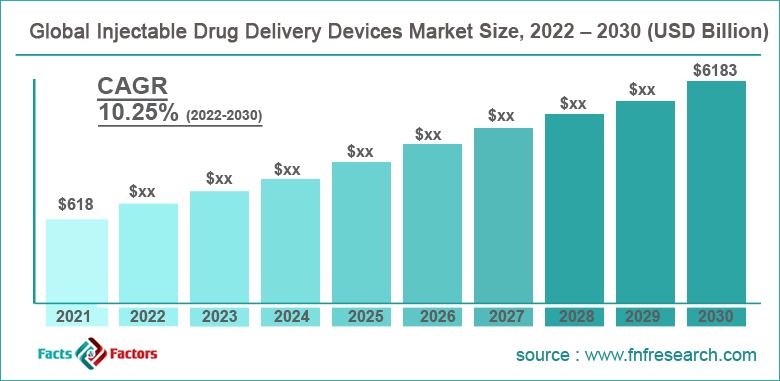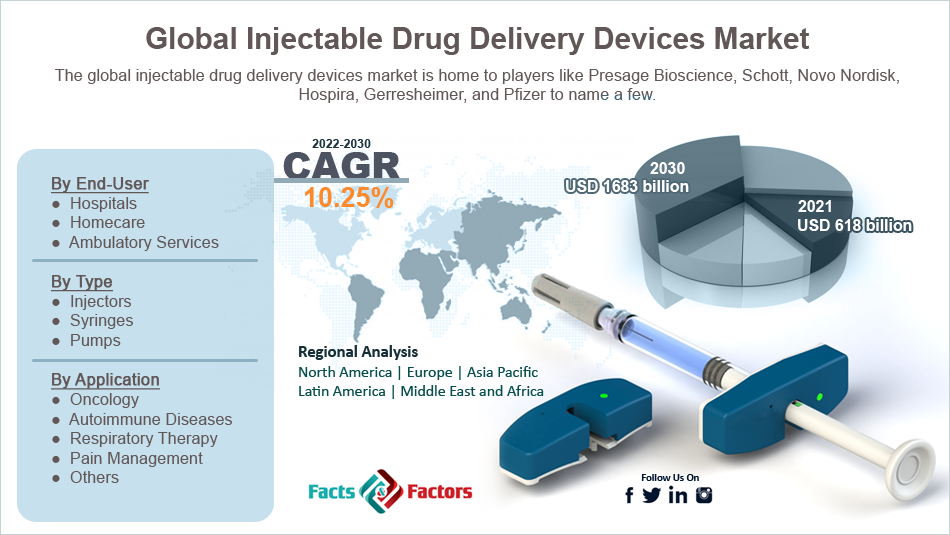Search Market Research Report
Injectable Drug Delivery Devices Market Size, Share Global Analysis Report, 2022 – 2030

Injectable Drug Delivery Devices Market Size, Share, Growth Analysis Report By End-User (Hospitals, Homecare, and Ambulatory Services), By Type (Injectors, Syringes, and Pumps), By Application (Oncology, Autoimmune Diseases, Respiratory Therapy, Pain Management, and Others), and By Region - Global and Regional Industry Insights, Overview, Comprehensive Analysis, Trends, Statistical Research, Market Intelligence, Historical Data and Forecast 2022 – 2030
Industry Insights
[213+ Pages Report] According to the report published by Facts Factors, the global injectable drug delivery devices market size was worth around USD 618 billion in 2021 and is predicted to grow to around USD 1683 billion by 2030 with a compound annual growth rate (CAGR) of roughly 10.25% between 2022 and 2030. The report analyzes the global injectable drug delivery devices market drivers, restraints/challenges, and the effect they have on the demands during the projection period. In addition, the report explores emerging opportunities in the injectable drug delivery devices market.

 Market Overview
Market Overview
There are different ways of administering drugs to a patient and the intravenous route is one of the most widely used methods due to the high efficiency achieved during drug administration. In this method, a needle is injected into the patient and the solution in the container can either be a single dose or may lead to multiple infusions. In the latter procedure, the solution moves because of gravity from a medical-grade plastic bag with the help of a flexible tube leading the solution to a catheter which in turn is connected to a vein, which is generally in the forearm. The intravenous method is considered the best method of administering medicine because in this way the exact or precise dose of the drug can be given to the patient in less time and under the complete control of the medical professional.
The method is also highly preferred in case there are irritating solutions involved in the process which may cause discomfort to the patient if given subcutaneously, which is another method of injecting the drug in the patient; however, in this situation, the needle gets inserted into the fatty tissue present under the skin. Other benefits of using injections for drug delivery include uniform and rapid drug absorption especially when solutions are in aqueous form.
 Key Insights
Key Insights
- As per the analysis shared by our research analyst, the global injectable drug delivery devices market is estimated to grow annually at a CAGR of around 10.25% over the forecast period (2022-2030)
- In terms of revenue, the global injectable drug delivery devices market size was valued at around USD 618 billion in 2021 and is projected to reach USD 1683 billion, by 2030.
- The market is projected to grow at a significant rate due to the growing number of medical patients across the world
- Based on application segmentation, oncology was predicted to show maximum market share in the year 2021
- Based on end-user segmentation, hospitals were the leading users in 2021
- On the basis of region, North America was the leading revenue generator in 2021

 Growth Drivers
Growth Drivers
- Increasing number of medical patients across the globe to propel market demand
The global injectable drug delivery devices market is projected to grow owing to the increasing number of patients suffering from various treatable, non-treatable, mild to serious medical problems. In 2020 and 2021, the global market registered significant growth induced by the increased pressure on the healthcare sector due to Covid-19 which affected millions of lives. The second wave observed across many regions was more serious that the first wave due to the multiple mutations that the Covid-19 virus underwent.
Since there was no accurate and systematic protocol to be followed as a treatment plan for SARS-CoV-19, doctors and the medical community tried various methods to cure the patients. Although the situation seems to be under control by 2022, there are various other medical problems that still persist ranging from contagious common cold and flu to fatal conditions like cancer and human immunodeficiency virus infection (HIV). India considers HIV an epidemic and as of 2017, more than 2.14 million in the country are living with HIV, as reported by the National AIDS Control Organization (NACO).
 Restraint
Restraint
- Improper handling of injectable delivery devices to restrict market expansion
One of the key points that cannot be neglected when handling injectable drug delivery devices is that one piece of equipment cannot be used on two people. This is especially applicable to syringes and injections that have to be discarded after every use because they can lead to the spread of infection from one patient to another. A prime example of such incidents includes the spread of acquired immune deficiency syndrome (AIDS). In 2018, more than 21 people in India were infected with HIV since the same syringe was used for every patient. It can act as a major growth-restricting factor if patient safety is neglected when handling such devices.
 Opportunities
Opportunities
- Increasing product innovation to provide growth opportunities
The medical community is consistently adopting research & innovation driven by the ever-changing nature of diseases. The development activities have helped the global injectable drug delivery devices market players stay relevant for multiple years and this aspect is projected to help the global market grow further during the forecast period. For instance, in June 2020, the US Food and Drugs Administration (FDA) approved the use of Lyumjev™, a new insulin with rapid-acting which is expected to help patients with type 1 and type 2 diabetes. The insulin will aid management of high blood sugar levels.
 Challenges
Challenges
- Increasing availability of substitutes to challenge market growth
Patients have become hesitant toward injectable devices because of the multiple associated concerns like infection spread, swelling in the injection area, and pain amongst others issues. The trend in influencing the global market players to develop substitutes for medicines given through injectable devices in the form of drugs that can be taken orally could challenge the global market growth.
 Segmentation Analysis
Segmentation Analysis
The global injectable drug delivery devices market is segmented based on end-user, type, application, and region
Based on end-uses, the global market is segmented into hospitals, home care, and ambulatory services. In 2021, the hospital segment led the global market growth driven by multiple factors including a high influx of Covid-19 infected patients, a general increase in medical processes, and growing clinical research & trials alongside other causes. As per current estimates, more than 94% of the population has generated herd immunity against Covid-19. Ambulatory care refers to outpatient services that do not require the patient to get admitted to the hospital. These services are gaining a lot of popularity because of several benefits but they are limited to the conditions that can be effectively treated.
Based on application, the global market divisions are oncology, autoimmune diseases, respiratory therapy, pain management, and others. The global market registered significant revenue from the oncology segment due to the growing cancer cases across the world as well as increasing research to find cures for different types of cancer. The most common types of cancers include prostate cancer, breast cancer, rectal cancer, lung & bronchial cancer, and non-Hodgkin lymphoma amongst others. In 2020, more than 2.3 million women were diagnosed with breast cancer.
 Recent Developments:
Recent Developments:
- In November 2022, the US FDA approved a new injection called Tzield (teplizumab-mzwv) which can effectively help in delaying the onset of stage 3 type 1 diabetes in pediatric patients over 8 years with stage 1 or stage 2 diabetes and adults
- In October 2022, Eisai Pharmaceuticals inaugurated its new injectable drug delivery facility called Eisai Medicine Innovation Technology Solutions (EMITS) worth USD 69 million
 Report Scope
Report Scope
Report Attribute |
Details |
Market Size in 2021 |
USD 618 Billion |
Projected Market Size in 2030 |
USD 1683 Billion |
CAGR Growth Rate |
10.25% CAGR |
Base Year |
2021 |
Forecast Years |
2022-2030 |
Key Market Players |
Presage Bioscience, Schott, Novo Nordisk, Hospira, Gerresheimer, Pfizer, and others. |
Key Segment |
By End-User, Type, Application, and Region |
Major Regions Covered |
North America, Europe, Asia Pacific, Latin America, and the Middle East &, Africa |
Purchase Options |
Request customized purchase options to meet your research needs. Explore purchase options |
 Regional Analysis
Regional Analysis
- North America to lead with the highest market growth
The global injectable drug delivery devices market is projected to register the highest growth in North America led by the advanced medical infrastructure of the US and Canada. The American medical community is consistently ranked as the top medical centers in the world propelled by intensive research and development along with a high rate of innovation in terms of medical equipment. High healthcare accessibility allows the general population to benefit from the already well-established healthcare segment of these nations.
The regional growth could also be driven by the increasing US FDA approvals for new medicines and associated devices. For instance, as per official data, the agency approved around 50 novel therapeutics in 2021. At the start of the same year, Cabenuva (cabotegravir and rilpivirine, injectable formulation) was approved by FDA to be used as a complete regimen while treating AIDS.
 Competitive Analysis
Competitive Analysis
- Presage Bioscience
- Schott
- Novo Nordisk
- Hospira
- Gerresheimer
- Pfizer
The global injectable drug delivery devices market is segmented as follows:
 By End-User Segment Analysis
By End-User Segment Analysis
- Hospitals
- Homecare
- Ambulatory Services
 By Type Segment Analysis
By Type Segment Analysis
- Injectors
- Syringes
- Pumps
 By Application Segment Analysis
By Application Segment Analysis
- Oncology
- Autoimmune Diseases
- Respiratory Therapy
- Pain Management
- Others
 By Regional Segment Analysis
By Regional Segment Analysis
- North America
- The U.S.
- Canada
- Mexico
- Europe
- France
- The UK
- Spain
- Germany
- Italy
- Nordic Countries
- Denmark
- Sweden
- Norway
- Benelux Union
- Belgium
- The Netherlands
- Luxembourg
- Rest of Europe
- Asia Pacific
- China
- Japan
- India
- Australia
- South Korea
- Southeast Asia
- Indonesia
- Thailand
- Malaysia
- Singapore
- Rest of Southeast Asia
- Rest of Asia Pacific
- The Middle East & Africa
- Saudi Arabia
- UAE
- Egypt
- South Africa
- Rest of the Middle East & Africa
- Latin America
- Brazil
- Argentina
- Rest of Latin America
Industry Major Market Players
- Presage Bioscience
- Schott
- Novo Nordisk
- Hospira
- Gerresheimer
- Pfizer
Frequently Asked Questions

Copyright © 2024 - 2025, All Rights Reserved, Facts and Factors


